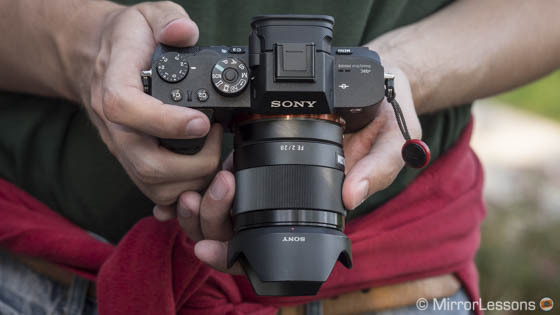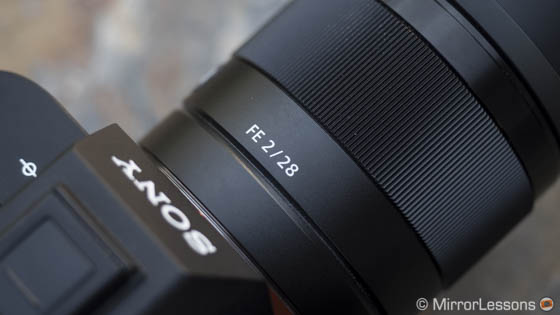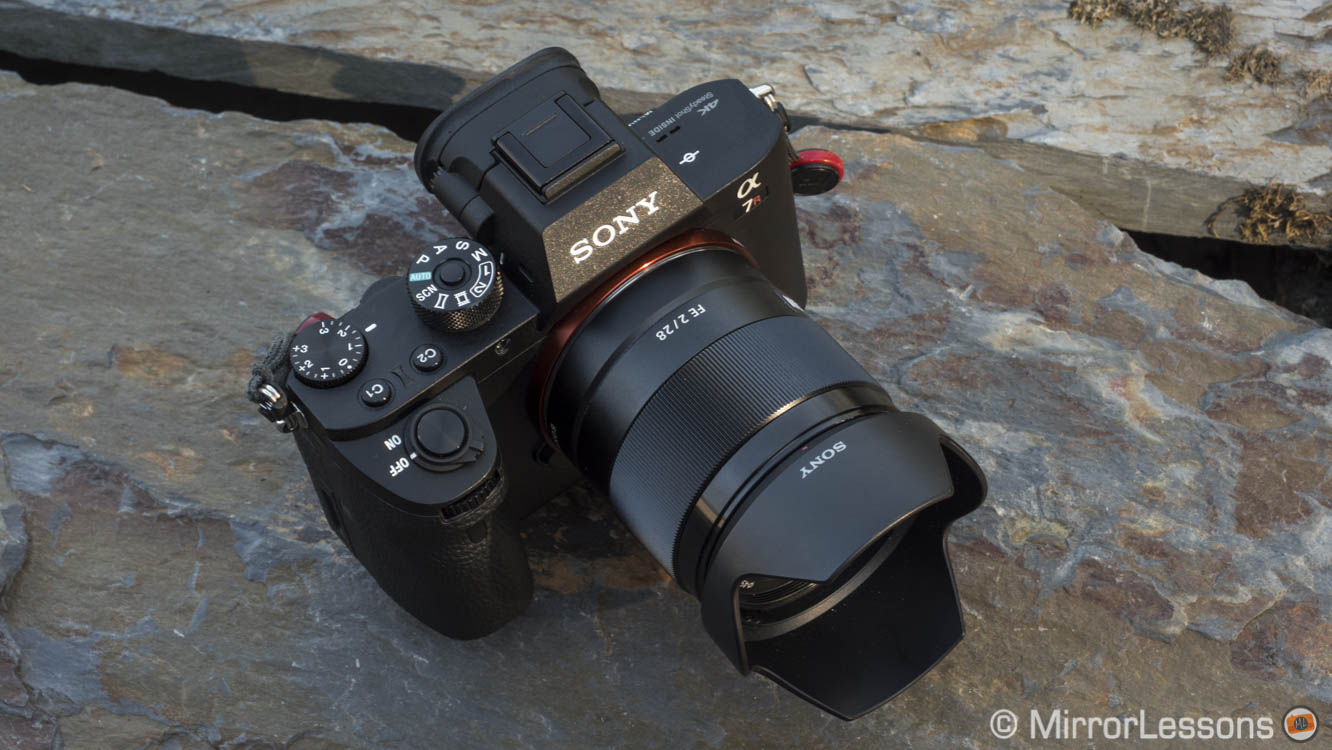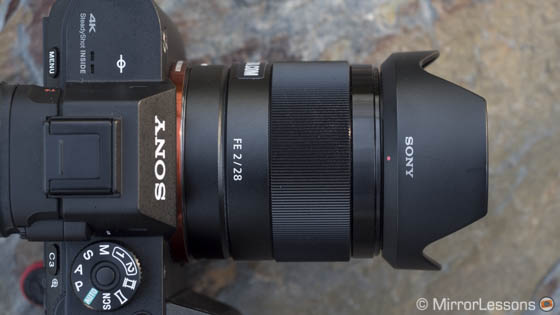While we can no longer complain about the lack of native FE lenses given that 15 have been produced in just two years, the Sony full-frame lineup is still missing a series of high quality/affordable glass. Now, to complain about this wouldn’t be completely fair since the system is new and still growing. Still, in the case of most mature camera systems, users can depend not only on high-end expensive lenses for the best image quality but also a more affordable range of products that still deliver very good IQ but at a more affordable price.
The 28mm f/2 may actually be one of the first FE lenses that meets much of the criteria of the latter group. It comes at a reasonable price, is small, lightweight and fast, and delivers good optical quality.
In short: we need more lenses like this!
Note: I spent one weekend with this lens, so this article is more a quick review than an in-depth analysis.



Sony FE 28mm f/2 Main Specs
- Focal length: 28mm (42mm on APS-C cameras)
- Maximum aperture: 2
- Minimum aperture: 22
- No. of aperture blade: 9 (circular)
- Angle of view: 75°
- Closest focusing distance: 29 cm
- Lens configuration: 9 elements / 8 groups
- Special elements: 1 Advanced Aspherical, 2 Aspherical and 2 ED elements
- Maximum image magnification: 0.13x
- Optical Image Stabiliser: None
- Dimensions: φ64mm Ø, 60mm
- Filter diamater: 49mm
- Weight: 200g
Design and Ease of Use
The FE 28mm f/2 is a compact and lightweight lens designed for the full-frame A7 series. It will also work with Sony APS-C cameras, giving you an equivalent focal length of 42mm. It has a high quality build with a metal surface and is dust and moisture resistant. Its size makes it very portable when paired with the A7r mark II and provides a very pleasant user experience. It comes with a petal-shaped plastic hood.

There aren’t any switches or buttons on the lens and the only part you can interact with is naturally the focus ring. A “fly-by-wire” type, it is large, smooth and precise to use, though I admit I rarely used it during my brief testing period.
The 28mm has been designed to work with two wide angle converters, the SEL075UWC and SEL057FEC. They change the focal length to a 21mm and Fisheye 16mm equivalent respectively. Unfortunately, I couldn’t try these two converters with the lens but I can refer you to an excellent review of the 21mm by Jordan Steele (Admiring Light).

Through the lens: optical quality
As usual, I’ll start by talking about sharpness at the fastest aperture. The 28mm can focus as close as 29cm and at f/2 it can render a decent bokeh. However I admit it isn’t my favourite characteristic of this lens at that aperture.

Click on the image to open the full res version.

Click on the image to open the full res version.

Click on the image to open the full res version.
I found that the lens gives more interesting results when you focus on subjects that are further away, like an ambient portrait. The bokeh becomes less attractive but the lens delivers more “character” and with the right light it can give the image a pleasant and “soft” look. Colour rendering is also excellent with the kind of natural and contrasty tones you’d expect from a modern digital lens.


The sharpness of the lens peaks at the centre between f/4 and f/5.6 but it still performs well at the faster apertures. At f/16 and f/22 some diffraction gets in the way but the performance remains more than decent. In the corners, the performance isn’t quite as good, with sharpness peaking at around f/8.


Click on the image to open the full res version.

Click on the image to open the full res version.
When it comes to distortion, we come across a commonality amongst FE lenses: there is lot of distortion that gets corrected by software (in-camera for JPGs and Lightroom or other Raw processing software for the ARW files). The 28mm is no exception with its barrel distortion, and even though the final result is perfectly fine, you always get that feeling that you’ve been forced into some sort of compromise. That said, it probably doesn’t matter since software is playing an increasingly important role in the final output of images anyway, be it in-camera or in post-production.
Flares and chromatic aberrations are very well-controlled. CA is almost non-existent even at f/2 while flares are very well contained.


Autofocus and performance
With the A7r mark II, I didn’t encounter any problems with the AF in both good and low-light conditions. The AF motor is fast and silent and behaves as expected, so there’s nothing to declare here.

The lens lacks optical stabilisation but I tested how far I could go with slow shutter speeds hand-held using the A7r II and its 5-axis stabilisation. Overall I would say that you can get good and constant results down to 1/5s. I managed to push it down to 1s only once after several attempts.


Conclusion
The FE 28mm f/2 leaves very little to be desired. It could benefit from some improved sharpness in the corners, but I wouldn’t advise you against buying the lens just for that reason.
Admittedly it isn’t my favourite focal length – I definitely prefer a 24/25mm lens – but if you force yourself to use it, it can work for a lot of different genres including landscapes, street, events and ambient portraits. It delivers good sharpness wide open and throughout the apertures at the centre. It is also small and light, and suits the camera (and the original mirrorless concept) really well.

The most appealing aspect of this lens is the price. At $450 you get an excellent product and right now it is the only FE lens that really embraces the idea of having quality and affordability in one package. I think it is important that Sony plans more lenses like this in the future.

Unfortunately I didn’t have the chance to test the two optional converters that give you a 21mm and 16mm Fisheye equivalent. I admit that converters are not a solution to which I am particularly attracted but they definitely give you the convenience of three focal lengths in one at an affordable price.
 What I like about the Sony 28mm f/2:
What I like about the Sony 28mm f/2:
- Compact and lightweight
- Good sharpness at f/2 and at the centre
- Good flare and C.A. resistance
- Great price
 What I don’t like about the Sony 28mm f/2:
What I don’t like about the Sony 28mm f/2:
- Sharpness at the corners gets better only at f/8







Good photos !
That only means that some hybrid lenses are not well done and some all-optical lenses are very well done. Not that there is anything inherent. cheers
All lenses (including Zeiss and Leica) get software correction so it is not surprising and I think it is pretty acceptable. But sometimes I am surprised by the difference you can get with the non corrected version. But you are probably right, I shouldn’t give it too much importance.
Thanks for the review. Your ambivalence about 28mm and preference for 24mm is interesting. 28mm is the typical wide end of all your usual kit zoom lenses: 28-80, 18-55 (APSC), 14-42 (µ4/3). Yet the ‘pro’ zooms all tend to go to 24mm: 24-70, 24-105, 16-50 (APSC), 12-35(µ4/3), 12-40 (µ4/3).
So, many entry-level buyers don’t get to experience 24mm.
On another matter, don’t feel (or write) that a lens is compromised by having software correction of distortion. In an all-optical design, the sharpest possible designs are distorted, and (partially) optically correcting the distortion requires some sacrifice of sharpness. In fact, going to a hybrid optical-software lens design is an opportunity to actually get a less compromised final result than going all-optical. Whether hybrid lens designers are doing this is a different discussion.
So, I would consider weather sealing as a plus:)
LOL you’re correct, sorry for the mistake.
Actually, Sony FE 28mm f/2 is weather sealed! http://www.sony.co.uk/electronics/camera-lenses/sel28f20-series#product_details_default
I hope so. They must release a cheap 50mm, every system needs one 🙂 I remember my Nikon 50mm 1.8 that I paid 135€ when I was using the D700.
The 16-35mm is a great lens but the converter would definitely save you some money and some weight.
I really hope this is the start of a family of quality Sony-branded (as opposed to Zony or Zeiss) lenses. Make them all f/2 would suit me fine. Get me a 50 mm and 85 mm and I think I’d be pretty well set. 135 mm f2.8? Maybe a 35 mm too. Yes, I know there are currently excellent 50 and 35 mm options but the Zonys are expensive.
In my dream camera cabinent I can’t decide if I’d get the Zony 16-35 or this + 21 mm converter.